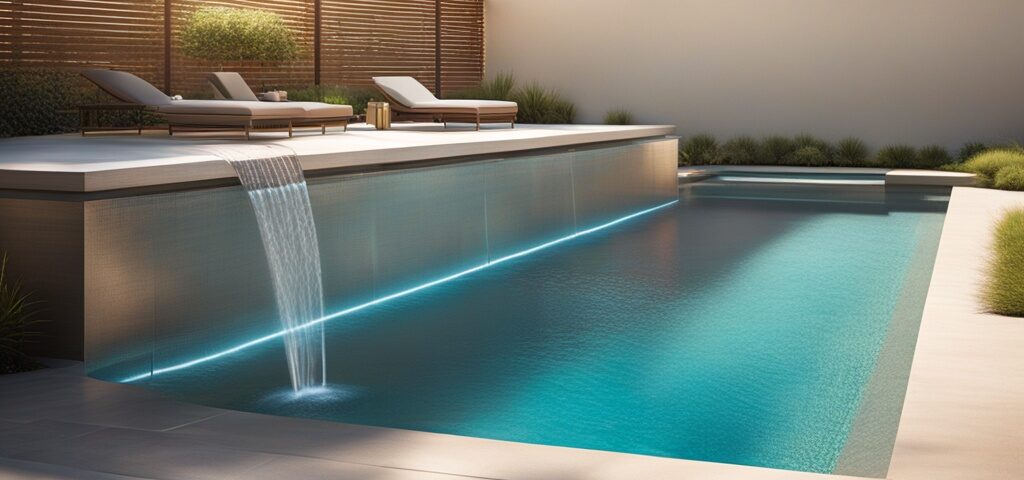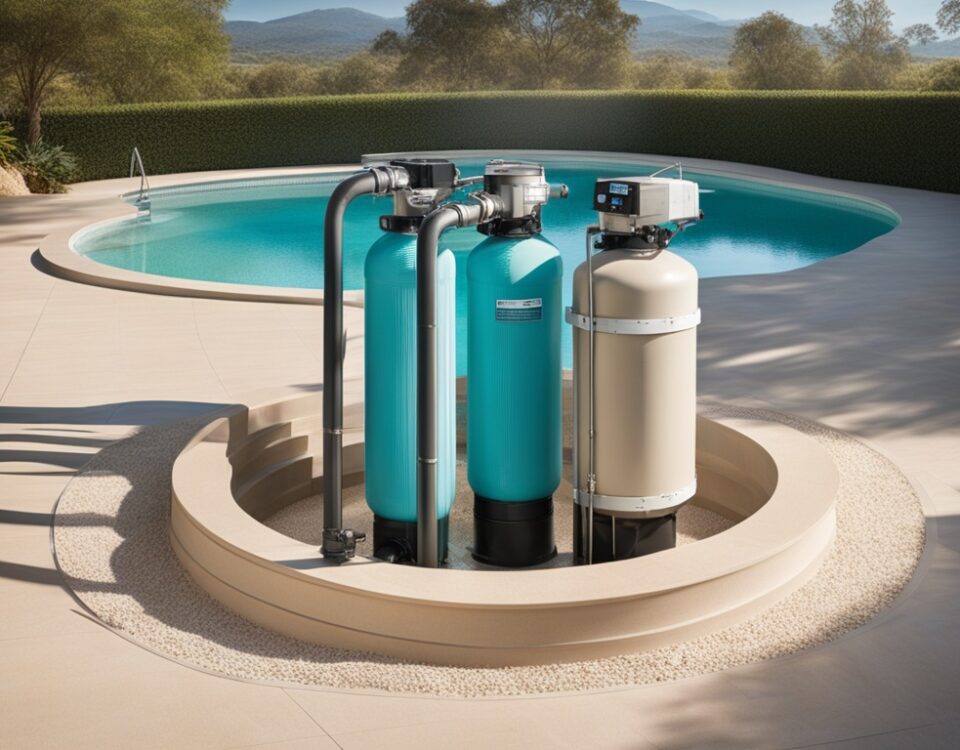Unlocking the Power: Variable Speed Pool Pump Benefits Revealed!

Unlock the Secrets: Your Ultimate Guide to Choosing the Perfect Pool Filter
May 4, 2025
Master the Art: Balancing Pool Chemicals Made Simple
May 5, 2025Understanding Variable Speed Pool Pumps
What are Variable Speed Pool Pumps
A variable speed pool pump is an advanced piece of equipment designed to optimize pool maintenance while significantly reducing energy consumption. Unlike traditional single-speed pumps, which operate at a constant speed, variable speed pumps can adjust their motor speed to cater to specific filtration and circulation needs. This allows for greater flexibility and efficiency, ultimately leading to enhanced pool health and reduced operational costs.
How do Variable Speed Pool Pumps Work
Variable speed pool pumps operate using a digital control system that allows users to set the desired flow rate for different pool tasks. With the ability to operate at multiple speeds, these pumps can perform circulation, filtration, and cleaning functions more effectively. The electronic drives control the motor’s RPM (revolutions per minute), optimizing the hydraulic flow and energy usage. For instance, during peak filtration times, the pump might operate at a higher speed, while it can be dialed down during quieter periods, maintaining the water quality without incurring excessive energy costs.
Advantages of Using Variable Speed Pool Pumps
The benefits of using variable speed pool pumps are manifold, providing not only monetary savings but also improved pool performance. *One of the most significant advantages is energy efficiency*. According to the U.S. Department of Energy, variable speed pumps can save pool owners up to 90% on energy costs compared to traditional pumps. This efficiency translates into lower utility bills, freeing up funds for other pool-related enhancements.
Another notable benefit is the *reduced noise levels*. Variable speed pumps can operate quietly, especially when set at lower speeds, allowing for a serene pool environment that enhances overall user experience. This feature is particularly advantageous for homeowners who value peace and tranquility in their outdoor spaces, making the pool area a true retreat.
| Feature | Variable Speed Pumps | Single-Speed Pumps |
|---|---|---|
| Energy Efficiency | Up to 90% savings | Standard consumption |
| Noise Levels | Quiet operation | Higher noise levels |
| Customization | Multiple speeds customizable | Single speed only |
| Initial Cost | Higher upfront cost | Lower initial cost |
Furthermore, variable speed pool pumps can lead to *longer equipment life spans*. By running at lower speeds during routine operations, these pumps experience less wear and tear compared to their single-speed counterparts. This longevity not only means fewer repairs but also prolongs the need for a full replacement, adding further financial benefits.
Lastly, the *environmental impact* of adopting variable speed pumps should not be overlooked. By utilizing such energy-efficient technology, pool owners contribute to a reduction in carbon emissions associated with high electricity usage. This eco-friendly approach aligns perfectly with the growing demand for sustainable practices in both residential and commercial environments.
Cost Savings with Variable Speed Pool Pumps
Variable speed pool pumps are not merely a trend in the swimming pool industry; they represent a significant leap in *energy efficiency* and operational cost reduction. The benefits of switching to a variable speed pump are profoundly evident in financial terms, as these units can lead to remarkable savings on *electricity bills*.
Energy Efficiency and Reduced Electricity Bills
One of the most compelling advantages of variable speed pool pumps is their energy efficiency. Unlike conventional single-speed pumps that operate at a fixed speed, variable speed pumps can adjust their speed according to the specific needs of the pool. This means that they can run at lower speeds for routine filtration and cleaning, consuming vastly less energy. Studies indicate that homeowners can expect to save between 30% and 90% on energy costs depending on usage patterns and pump settings.
Furthermore, many variable speed pumps are equipped with advanced technology, allowing for smart scheduling and monitoring. This capability enables users to program the pump to operate during off-peak hours when electricity rates tend to be lower, further enhancing savings. The long-term impact of this energy efficiency cannot be overstated, as a reduction in *electricity consumption* contributes not only to lower utility bills but also to a decreased carbon footprint.
Long-Term Savings on Maintenance and Repairs
In addition to energy savings, variable speed pumps offer *long-term financial benefits* through reduced maintenance and repair costs. Traditional single-speed pumps often operate at maximum capacity, which can lead to excessive wear and tear on components. In contrast, the ability to run at variable speeds results in less strain on the pump and associated equipment, ultimately extending the lifespan of the entire pool system.
According to industry data, operators can reduce maintenance costs by approximately 50% when utilizing variable speed pumps compared to traditional models. The decrease in mechanical wear results in less frequent need for repairs and replacements, which not only contributes to immediate cost savings but also allows pool owners to allocate funds towards *enhancing their pool experience* rather than merely addressing mechanical issues.
| Type of Pump | Energy Savings (%) | Maintenance Cost Reduction (%) |
|---|---|---|
| Single-Speed Pump | 0-30% | 0% |
| Variable Speed Pump | 30-90% | 50% |
In light of these considerations, the shift toward variable speed pool pumps is increasingly becoming a financially astute decision for many pool owners. As awareness about energy efficiency grows, the trend shows no signs of slowing down, solidifying the variable speed pump’s role as a cornerstone of modern pool maintenance and management.
Environmental Benefits of Variable Speed Pool Pumps
Variable speed pool pumps offer a multitude of *environmental benefits*, primarily through their ability to significantly lower energy consumption. Unlike traditional single-speed pumps that operate at maximum capacity regardless of need, variable speed pumps can adjust their speed according to the specific demands of the pool. This capability not only leads to enhanced efficiency but also results in massive reductions in electricity usage, which is notably beneficial for both the environment and the wallet. According to the U.S. Department of Energy, variable speed pumps can save up to *70% on energy costs*, translating to a markedly reduced carbon footprint for pool owners.
Lower Energy Consumption and Reduced Carbon Footprint
The relationship between energy usage and carbon emissions is direct: the more electricity consumed, the greater the carbon output. By utilizing a variable speed pool pump, homeowners can drastically decrease their energy consumption. For instance, *operating at lower RPMs* for extended periods allows for equally effective filtration – all while minimizing the actual energy drawn from the grid. This translates into fewer fossil fuels burned and a decrease in greenhouse gases emitted, ultimately fostering a healthier planet. When you consider the collective number of swimming pools across the globe, the impact of this shift to more efficient pumps can be profound.
Eco-Friendly Options for Pool Owners
In addition to their operational efficiency, variable speed pool pumps often accompany *eco-friendly features* that pool owners can exploit. Many modern models are designed with eco-shaped attributes, such as advanced materials and energy-efficient manufacturing processes. Furthermore, these pumps contribute to the overall sustainability of pool ownership by reducing the frequency of chemical usage. With better filtration capabilities and a longer operational period, the need for harsh chemicals to balance water quality diminishes, leading to cleaner water that is more harmonious with the local ecosystem.
| Feature | Traditional Pool Pump | Variable Speed Pool Pump |
|---|---|---|
| Energy Consumption | High (100% at all times) | Low (15-30% for various speeds) |
| Cost Savings | $300 – $700 annually | $100 – $200 annually |
| Carbon Footprint | High | Significantly Reduced |
| Noise Level | High | Low |
Moreover, many variable speed pumps are compatible with *smart technology*, allowing for easier integration into environmentally conscious home automation systems. This technology can facilitate the control of the pump’s operation remotely, enabling homeowners to optimize energy use seamlessly. Through monitoring and adjusting their pool system, consumers can easily ensure that energy consumption remains low, directly contributing to a lower carbon footprint.
In light of these numerous advantages, it is evident that opting for a variable speed pool pump is not merely a financial decision; it is one that resonates with the ethos of *sustainability*. As consumers increasingly seek to minimize their environmental impact, these pumps stand as a testament to innovative technology and eco-friendliness in pool care. The transition to variable speed pumps offers a resounding win-win scenario, merging the joys of pool ownership with the responsibility of environmental stewardship.
Improved Pool Performance with Variable Speed Pool Pumps
Better Circulation and Filtration for Cleaner Water
One of the most significant advantages of variable speed pool pumps lies in their ability to enhance water circulation and filtration. Traditional single-speed pumps operate at a constant high speed, which can lead to poor circulation, especially in larger pools. In contrast, variable speed pool pumps can be adjusted to run at lower speeds, resulting in a more consistent flow of water throughout the pool. This improved circulation is vital for preventing stagnant water, reducing the likelihood of algae growth, and maintaining crystal-clear water.
Moreover, with slower pump speeds, the filtration system operates more efficiently. When water passes through the filter more slowly, it allows for greater contact time with the filtration medium, promoting the effective removal of debris and contaminants. As a result, pool owners can enjoy cleaner, healthier water without the need for excessive chemical treatments, contributing to a more enjoyable swimming experience.
Customizable Speed Settings for Optimal Pool Maintenance
The true genius of variable speed pumps lies in their customizable speed settings. Pool owners can tailor their pump’s operation to meet specific needs, adjusting the speed according to different maintenance tasks. For instance, during routine cleaning, the pump can be set to a higher speed to facilitate thorough suction and circulation, ensuring that leaves and other debris are efficiently collected. Conversely, during regular operation, a lower speed can be employed for economical filtration.
This versatility not only promotes energy efficiency but also allows users to engage in more nuanced pool maintenance. Different activities such as heating the pool, running spa jets, or utilizing water features can also benefit from the pump’s adjustable speeds. Such customization ensures that every aspect of pool operation is optimized, contributing to overall water clarity and performance.
Enhanced Longevity and Reduced Wear
Another compelling benefit of variable speed pool pumps is their ability to extend the lifespan of your pool equipment. By operating at lower speeds, these pumps exert less stress on the motor and associated components, significantly reducing wear and tear. This characteristic is particularly beneficial for long-term cost efficiency, as it minimizes the need for frequent repairs or replacements, prolonging the life of both the pump and the pool’s filtration system.
| Variable Speed Pump Advantages | Traditional Single-Speed Pumps |
|---|---|
| Water Circulation Efficiency | Lower efficiency and potential stagnation |
| Energy Consumption | Higher energy costs and waste |
| Filtration Quality | Inconsistent filtration |
| Maintenance Flexibility | Limited operational settings |
Ultimately, selecting a variable speed pool pump not only maximizes pool performance but also aligns with sustainable practices, promoting a cleaner, more enjoyable swimming environment while conserving energy and resources.
Noise Reduction and Durability of Variable Speed Pool Pumps
One of the standout advantages of variable speed pool pumps is their remarkable *noise reduction capabilities*. Unlike traditional single-speed pumps, which often operate at a constant high speed and create considerable noise, variable speed pumps are designed to run quietly. By allowing users to adjust the pump speed according to their specific needs, these pumps can operate at significantly lower RPMs, contributing to a more peaceful backyard environment. This feature is especially advantageous for homeowners looking to enjoy their outdoor spaces without the constant drone of a traditional pool pump.
Quieter Operation Compared to Traditional Pool Pumps
The quieter operation of variable speed pool pumps is achieved through advanced engineering and technology. While standard pool pumps generally produce noise levels that can exceed 70 decibels, which is comparable to a vacuum cleaner, variable speed pumps typically operate at noise levels below 45 decibels. This difference is not only significant but also has a profound effect on the overall enjoyment of your pool area. Whether you’re hosting a summer barbecue or simply enjoying a quiet evening under the stars, a variable speed pump’s serene operation enhances the ambiance of your outdoor living space.
Longer Lifespan and Reduced Wear and Tear on the Motor
Another major benefit of variable speed pool pumps is their *durability*, which translates into a longer lifespan compared to traditional pool pumps. The innovative technology enables these pumps to operate at lower speeds, reducing wear and tear on the motor. This gentle operation minimizes the stress on internal components, which is a common issue with high-speed pumps that often lead to overheating and premature burnout. As a result, variable speed pumps can last significantly longer, often providing years of reliable service with proper maintenance.
In addition to longevity, variable speed pumps also contribute to reduced maintenance costs. The lower operational speeds, coupled with their energy efficiency, mean that these pumps not only save users money on electricity bills but also lessen the frequency of repairs. With fewer components stressed and subjected to wear, homeowners can enjoy peace of mind knowing that their investment in a variable speed pool pump is both economically and environmentally savvy.
Comparative Overview of Pump Noise and Lifespan
| Pump Type | Noise Level (Decibels) | Average Lifespan (Years) |
|---|---|---|
| Traditional Single-Speed Pump | 70+ | 5-7 |
| Variable Speed Pump | Less than 45 | 10-15 |
Ultimately, opting for a variable speed pool pump not only enhances the *acoustic landscape* of your property but also represents a smart choice in terms of durability and maintenance. These pumps are engineered to endure, providing a sustainable solution that marries functionality with environmental consciousness. As homeowners increasingly prioritize noise reduction and pump longevity, the benefits of variable speed pool pumps become ever more compelling.
Smart Technology Integration in Variable Speed Pool Pumps
In the evolving landscape of pool maintenance and energy efficiency, smart technology integration has emerged as a pivotal feature in the realm of variable speed pool pumps. These sophisticated devices not only optimize energy consumption but also enhance user convenience through innovative remote monitoring and control capabilities.
Remote Monitoring and Control Features
One of the standout benefits of variable speed pool pumps is their ability to offer remote monitoring and control features. Many modern pumps are equipped with Wi-Fi connectivity, allowing homeowners to monitor their pool’s conditions from anywhere within the reach of an internet connection. Whether at work or on vacation, users can check pump performance, water temperature, and energy usage, all via a user-friendly mobile app. This level of access empowers pool owners to make informed decisions regarding their pump settings in real-time, ensuring optimal performance without the need for physical presence.
Furthermore, remote control functionalities enable users to adjust pump speed and runtime with *a mere touch of a button*. This flexibility is particularly advantageous during peak usage times or changing weather conditions, as it allows for seamless adjustments to optimize energy consumption and maintain water quality. The ability to schedule operation times and run diagnostic checks remotely substantially enhances the overall user experience, making pool maintenance more efficient.
Compatibility with Pool Automation Systems
The integration of variable speed pool pumps with existing pool automation systems is another notable benefit. These pumps are designed to be *compatible with various automation platforms*, allowing for a cohesive approach to pool management. For homeowners who have invested in advanced pool systems, pairing variable speed pumps with automation technology results in a harmonious balance of convenience and efficiency.
Through automation, users can synchronize their variable speed pool pumps with other crucial systems, such as heating, lighting, and cleaning. This interconnectedness not only streamlines maintenance but also allows for automated energy-saving modes that actively manage the pump’s operations based on real-time data. For instance, a pool pump can adjust its speed based on the pool’s water temperature or when a pool cleaner is in operation, thereby eliminating unnecessary energy consumption.
| Feature | Benefits |
|---|---|
| Remote Monitoring | Access pump status anytime, anywhere; check water conditions remotely. |
| Remote Control | Adjust pump settings instantly; program schedules for optimal operation. |
| Automation Compatibility | Integrate with heating, lighting, and cleaning systems for seamless control. |
| Energy Efficiency | Reduce power consumption; extend pump lifespan through optimized use. |
As smart technology continues to advance, the scope of control and monitoring for variable speed pool pumps will likely expand further. Innovations such as artificial intelligence and machine learning could soon be incorporated, enabling pumps to learn user preferences and automatically optimize their performance based on the unique needs of each pool environment. This transition marks not merely an enhancement of convenience but also a significant stride towards *sustainable pool maintenance practices*.
Installation and Maintenance Tips for Variable Speed Pool Pumps
Proper Installation Guidelines for Optimal Performance
Installing a variable speed pool pump requires meticulous attention to detail to ensure *optimal performance*. Begin by selecting a location that is ideally close to the pool and away from obstructions. Consider placing the pump within a well-ventilated area to enhance cooling and air circulation. Ensure that the pump is installed on a solid, level surface that can withstand vibrations during operation. This foundational step is crucial for minimizing noise and maintaining operational efficiency.
Before installation, be sure to review the manufacturer’s guidelines carefully. Proper plumbing connections are vital; use the appropriate fittings and minimize the length of suction and discharge lines to prevent unnecessary pressure loss. *Sealing connections securely* is imperative to avoid leaks, which can hinder performance and lead to water loss. Finally, install a union fitting on both sides of the pump, which will facilitate *future maintenance* with ease.
Routine Maintenance Practices to Prolong the Life of the Pump
Once your variable speed pool pump is installed, routine maintenance becomes essential to prolong its lifespan and maintain *efficiency*. Regularly check and clean the pump strainer basket to ensure smooth operation, as debris can block water flow, leading to increased energy consumption and wear on the motor. It is advisable to perform this cleaning process at least once every few weeks, particularly during peak swimming months.
In addition to cleaning the strainer basket, monitor the water chemistry of your pool. Maintaining balanced water chemistry not only prevents corrosion but also protects the pool pump from undue stress caused by acidic or basic water. Ideally, the pH level should range between 7.4 and 7.6, which reduces wear on the mechanical components of the system.
Regular Checks and Component Lubrication
Conduct regular inspections of your pump’s motor and electrical connections to identify any potential issues before they escalate. Look for signs of wear or overheating, and ensure that all electrical connections are secure. To enhance longevity, consider lubricating the motor and any moving parts as per the manufacturer’s recommendations, using the right type of lubricant that is compatible with the components.
| Maintenance Task | Frequency |
|---|---|
| Clean pump strainer basket | Every 2-4 weeks |
| Inspect electrical connections | Monthly |
| Lubricate motor and moving parts | Seasonally |
| Check water chemistry | Weekly |
Finally, be attentive to unusual noises or performance dips. While variable speed pumps are generally quieter than their single-speed counterparts, sudden changes in noise levels may indicate a problem. Promptly addressing any irregularities can save you from costly repairs down the line and ensure that your pool remains a haven of relaxation.
Learn more about Swimming Pool

Javier Morales is passionate about pool design, maintenance, and outdoor living. With years of hands-on experience, he offers practical tips, creative ideas, and expert insights to help readers make the most of their pool spaces. At Piscina Planet, Javier shares everything from seasonal care guides to the latest trends in pool innovation.




